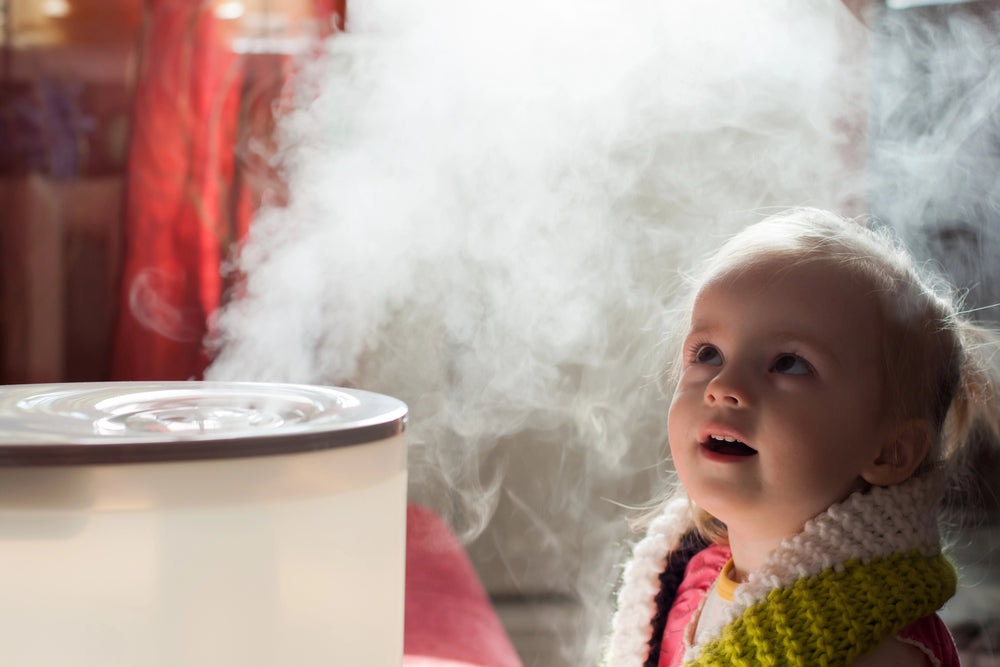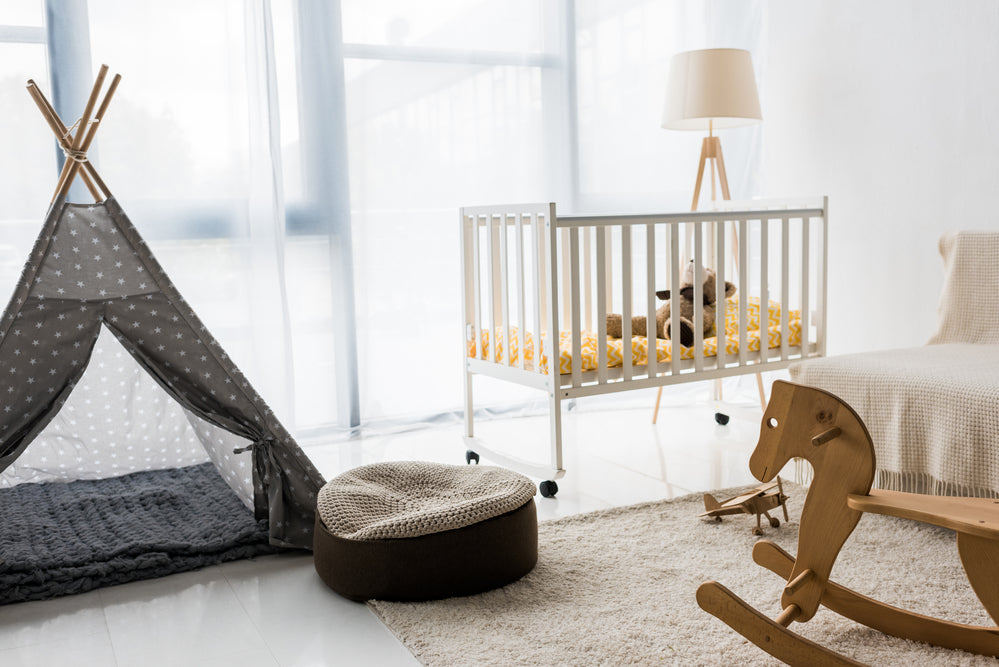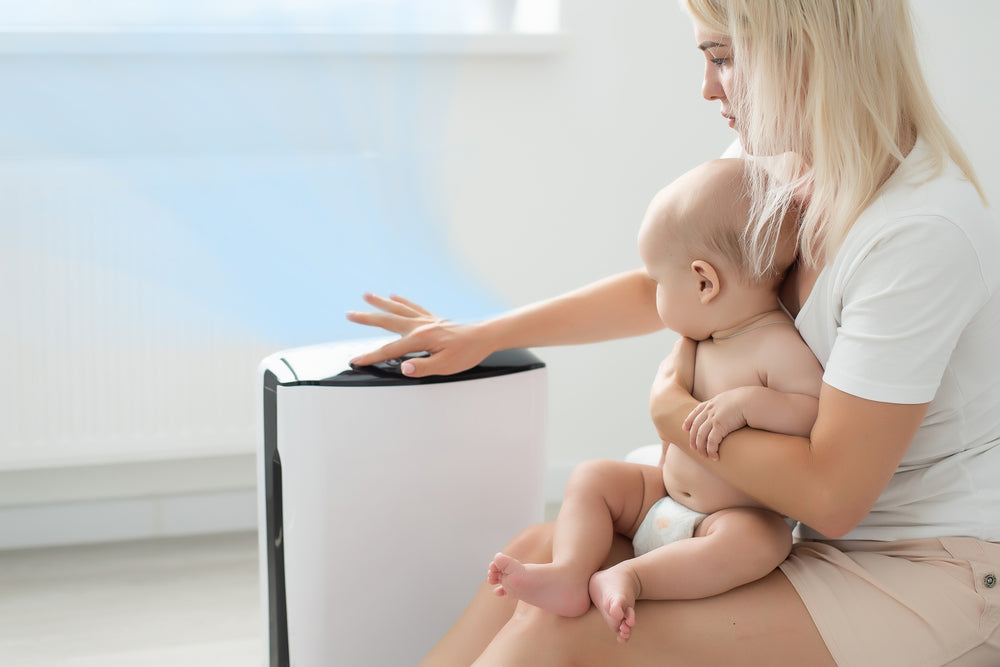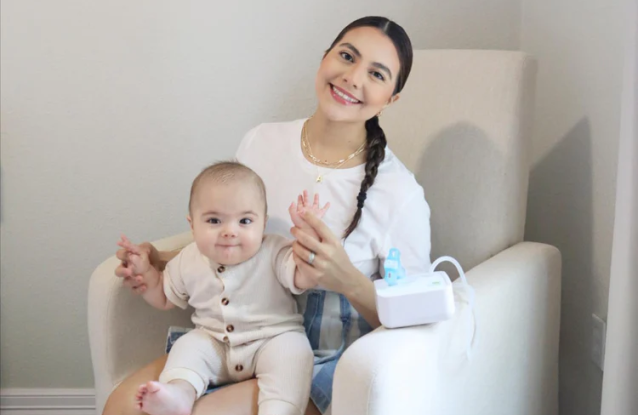When your little one is sick, you’ll do anything to make them feel better. And when they’re well, you’ll do anything to keep them that way. While plenty of health remedies are available, sometimes a simple solution can work wonders. That’s where a baby humidifier comes in.
This small appliance adds moisture to the air in your baby’s room, making it easier for them to breathe. But that’s not the only thing it does.
In this guide, we’ll explore the benefits of using a humidifier, safety precautions to keep in mind, and how to choose the best one for your bundle of joy.
Table of Contents
Baby Humidifier Benefits

A baby humidifier turns water into a fine mist and then releases it into the air. This raises the level of moisture, known as humidity, of a room.
Both adults and children can use humidifiers, but specific models work well in nurseries. These often include kid-friendly features, like built-in night lights, white noise options, and auto shut-off settings.
Regardless of the design features, using a humidifier in your baby’s room can be beneficial. Here are some of the main reasons parents choose to use one:
- Eases congestion: When your little one has a stuffy nose, it can be hard for them to breathe or sleep. Adding extra moisture to the air can help loosen mucus and minimize congestion. This is especially helpful for babies who can’t yet blow their nose.
- Relieves dry skin: Some babies are prone to dry, itchy skin, particularly during winter. Raising the humidity level can help keep their skin moisturized and reduce discomfort.
- Aids in sleep: No one wants to sleep in a dry, stuffy room. A humidifier can help create a comfortable environment that promotes sleep. It provides calming white noise and eliminates dry air.
When To Use A Baby Humidifier
There isn’t necessarily a “right” or “wrong” time to use a humidifier for your baby. In fact, humidifiers are great for daily use to help your baby breathe easier in general and to prevent colds.
That said, there are certain situations in which a baby humidifier can be especially helpful.
During Cold Or Flu Season
When cold and flu bugs are going around, a humidifier can help keep the respiratory system moist, making it harder for germs to settle in and cause infection.
In Dry Climates
If you live in an area with low humidity, your baby may be more susceptible to dry skin and respiratory issues. You may need to use a humidifier around the clock to keep the indoor humidity level between 30-50%.
While you may be tempted to go higher, anything above that can create a breeding ground for mold and bacteria spores.
When Your Baby Is Sick
Turn on the humidifier (especially at night) anytime your baby’s nose gets snotty. Respiratory illnesses can be more uncomfortable for babies who have to breathe dry air.
Baby Humidifier Safety Tips
Safety should be a top priority whenever you use a baby humidifier. Read your owner’s manual carefully for guidance on how to use your specific device.
Here are a few general safety tips to keep in mind.
Keep It Clean
Whenever you have a container with water in it, you run the risk of mold and bacteria growth. If mold gets inside your humidifier, the spores will be blown out right into your baby’s room, creating a health nightmare.
To prevent this, regularly clean and disinfect your humidifier according to the manufacturer’s instructions. Depending on your device, this could include:
- Regularly rinsing the tank and filling it with new water
- Wiping down the inside of the tank with a mild cleaning solution
- Removing components to clean under them
- Disinfecting the parts regularly
- Replacing the filter as needed
Use Distilled Water
While filling your humidifier with tap water is convenient, it’s not the safest option. Tap water contains minerals that can leave deposits on your humidifier, promoting bacteria growth. The humidifier can release these deposits into the air, causing respiratory problems for your baby.
Using distilled water is a safer alternative. It has fewer minerals and doesn’t leave deposits behind.
Opt For Cool Mist
The two primary types of humidifiers are cool mist and warm mist. While warm mist may sound cozier, it’s not necessarily better for your baby.
As you might imagine, the warm mist can burn your baby if they get too close. Plus, with a water heater inside the unit, there’s always a risk of burns or scalds from accidental spills. Cool mist humidifiers use room temperature water, making them a safer choice around children.
Monitor The Room’s Conditions

You want your baby's air to be just right — not too dry or wet. If the room becomes too moist, there’s a risk of mold growth. Excessive water in the air can also damage furniture.
Check the room’s humidity level periodically and ensure it’s between 30-50%. If it’s not, adjust the settings on your humidifier or turn it off if necessary.
Limit Essential Oil Use
While aromatherapy is growing in popularity, there’s limited research about its safety for children under three. Essential oils can be harmful when ingested or applied undiluted to the skin. Releasing them as a vapor from a humidifier can also irritate your baby’s respiratory system.
Talk to your doctor about essential oils before you add any to your baby’s humidifier. They can help you select the safest options.
Be Mindful Of Cords
Before turning on your humidifier, carefully consider where to put it. You’ll need to make sure your little one can’t grab the cord and yank the unit onto themselves.
Electrical cords pose strangulation hazards to young children, so keep them out of reach or tuck them behind the furniture to prevent accidents.
Humidifier Features To Consider
Here are some features to consider when shopping for a humidifier for your baby’s room.
Type Of Humidifier
You can buy two types of cool mist humidifiers: ultrasonic and evaporative. Ultrasonic humidifiers use high-frequency vibrations to generate water vapor, while evaporative ones use a fan to blow air through a wet wick or filter.
Both types have pros and cons, so it’s important to consider your specific needs.
Ultrasonic models tend to be quieter and consume less energy. But since they don’t have a filter, these humidifiers can release minerals or other contaminants into the air.
Evaporative humidifiers are often more affordable and filter the air to prevent particles from blowing out. However, you’ll have to buy new filters regularly, which adds to the overall cost.
Size And Capacity

You need a humidifier the right size for your baby’s room. A model that’s too big may create excess moisture, while one that’s too small won’t provide enough.
Manufacturers indicate the recommended room size for each model, so check out the specifications before purchasing.
You’ll also want to pay attention to the tank’s capacity. The larger the tank, the less often you’ll need to refill it.
Nightlight
Some models come with a built-in nightlight, which can be helpful during nighttime feedings and diaper changes. It can also help older kids who are scared of the dark.
Just make sure the light isn’t too bright so it could disturb your little one’s sleep.
White Noise Capability
A soothing white noise can help lull your baby to sleep, while a jarring or overly loud humidifier can have the opposite effect.
When buying a baby humidifier, pick one that’s not too loud. Even better, look for one with built-in white noise or sound machine capabilities.
Smart Technology
In today’s connected world, smart technology integrates into many household items, including humidifiers. Models equipped with Wi-Fi connectivity allow you to adjust the settings remotely through an app, so you won’t have to go into your baby’s room to make changes.
Automatic Shut-Off
Life with a baby can be crazy sometimes, so there may be days when you forget to fill the humidifier. To avoid accidents, choose a model with an automatic shut-off feature.
This will turn off the device when the water level gets too low, preventing it from running dry and potentially burning out the motor or causing a fire.
Your Baby Deserves To Breathe Better!

Running a baby humidifier can make a big difference in your little one’s comfort and overall health. For an even bigger impact, complement your new humidifier with a suction device, like the NozeBot® from Dr. Noze Best, that gently and effectively clears your baby’s snotty nose.
When your baby can breathe better, so can you. So, pick up a baby humidifier and a NozeBot® Electric Nasal Aspirator for a happy, healthy household!
If you enjoyed this article, you may also love:
- What to Do Immediately When Your Child is in Respiratory Distress
- How to Prepare for Your Baby’s First Cold
- The Importance of Air Quality Around Newborns
- 8 Natural Cold Remedy Myths Debunked
- 5 Things to Know About Nasal Hygiene
The Nozebot is a battery-powered suction device designed to clear nasal congestion in babies and children.



